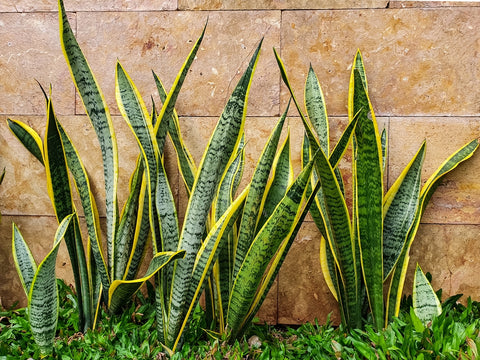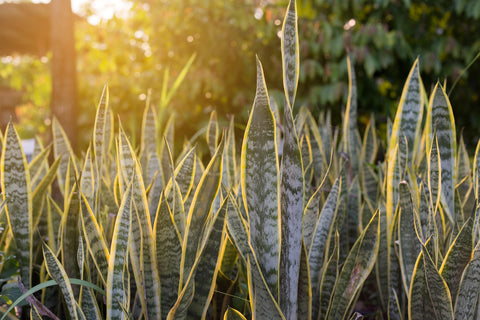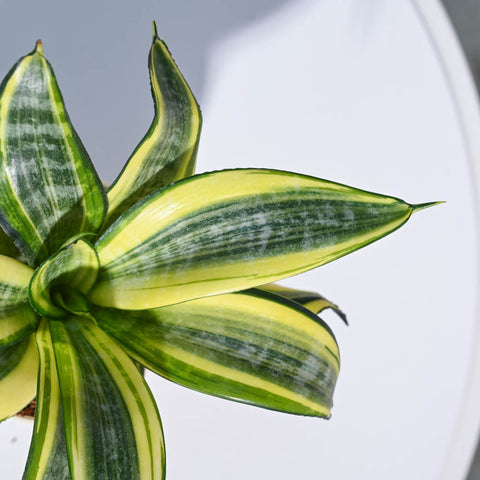Called Dracaena trifasciata scientifically, the Snake Plant is a popular indoor plant - and with very good reason. With its countless benefits and easy maintenance, it makes for a brilliant companion and does not require too much time of your day. - just a little bit of care and nurturing goes a long way.
By now, if you're wondering what these highly talked-about Snake Plant benefits are, you're in the right place. Continue reading to find out more about the Dracaena trifasciata.
• Origins of the Dracaena Trifasciata
The Dracaena trifasciata has many other names, some more commonly used than the rest. Its various common names, such as snake plant, mother-in-law's tongue, viper's bowstring hemp, and Saint George's sword reflect its long, sword-shaped leaves with distinctive patterns.
The Sansevieria trifasciata Snake Plant comes from a rich history of its own that dates back to its native regions in West Africa, including Nigeria and the Congo Republic.
In its natural habitat, the snake plant can thrive in a variety of conditions. From dry and arid climates to more humid environments, the mother-in-law's tongue showcases its hardy adaptability and unparalleled resilience.
• Sansevieria Trifasciata Etymology: How Was It Named?
The scientific name, Sansevieria trifasciata, reflects its classification within the Sansevieria genus.

The genus is named after the Italian Prince Raimondo di Sangro. He was a patron of horticulture and a member of the Sansevero family - a noble Italian family that represented the upper class of the country.
"Trifasciata" refers to the three stripes or bands that adorn the plant giving it its distinctive and memorable appearance.
• Snake Plants: Significance and Symbolism
The Snake Plant holds cultural significance in various parts of the world. In Chinese culture, it is believed to bring good luck and prosperity to the household, while in African folklore, it is considered a symbol of protection against evil spirits.
Its ability to thrive in low light conditions and survive with minimal water has contributed to its reputation as a symbol of resilience.
• What Are The 10 Benefits of Snake Plant?
As mentioned earlier, the snake plant has countless benefits that make it the perfect indoor plant if you're looking to get into the world of plants or even just add to your indoor collection. Here are a few snake plant advantages:
1. Air Purification:
One of the standout features of the snake plant is its exceptional ability to purify the air. The snake plant excels at air purification through continuous oxygen release and toxin absorption, making it an ideal indoor companion.
Its unique ability to perform photosynthesis day and night enhances oxygen levels, while effectively removing pollutants such as formaldehyde, benzene, and xylene, contributing to a healthier and fresher indoor environment.
2. Low Maintenance:
Snake plants are immensely resilient and require minimal care. This is one of the best benefits of Mother-in-Law Tongue Plant because it meant they can survive the most unexpected conditions.
They can thrive in low light conditions, tolerate irregular watering, and even withstand neglect, making them an excellent choice for busy individuals or for those who new to plant care.

3. Improved Sleep Quality:
The Sansevieria trifasciata Snake Plant is known for releasing oxygen at night, unlike most plants that only do so during the day. This unique characteristic can contribute to better sleep quality and create a healthier indoor environment.
4. Adaptability:
Whether placed in a pot or hanging basket, indoors or outdoors, snake plants adapt well to different environments. Their versatility allows them to complement various interior and landscaping designs.
5. Enhanced Productivity:
The presence of indoor plants, including snake plants, has been linked to increased productivity and concentration. Their calming and visually pleasing nature creates a more conducive atmosphere for work and relaxation.
6. Natural Humidifier:
Snake plants release moisture during transpiration, making them natural humidifiers. This can be particularly beneficial in dry climates or during the winter months when indoor air tends to be drier.
7. Aesthetic Appeal:
Buy Snake Plant - Golden
With their architectural leaves and striking patterns, snake plants add a touch of elegance to any space. The variegated varieties, such as Sansevieria trifasciata laurentii, bring an extra layer of visual interest.
8. Longevity:
Sansevieria trifasciata varieties are known for their longevity, and with proper care, they can thrive for many years. This makes them an enduring and sustainable choice if you're looking for long-lasting greenery.
9. Snake Plant Propagation:
Snake plants are one of the easiest to propagate. It can be done through division or leaf cuttings, and it's a rewarding process for beginners.
10. Stress Reduction:
Beyond its physical benefits, the snake plant has been associated with stress reduction. The presence of greenery indoors has been linked to lower stress levels and improved mental well-being. The snake plant's calming aesthetics and easy maintenance make it a soothing addition to any space, promoting a sense of tranquility.
There are multiple Sansevieria trifasciata varieties, but regardless of which one you choose, the benefits remain constant.
With the right care and just a little time, and effort, maintaining a healthy snake plant is a breeze.
• Care Tips and Growing Conditions for Snake Plants
a. Light:
Snake plants can tolerate a wide range of light conditions, from low to bright indirect light. However, they grow best in medium to low light.
b. Watering:
Allow the soil to dry out completely between waterings. Snake plants are susceptible to root rot if overwatered, so err on the side of underwatering.
c. Soil:
Well-draining soil is crucial for snake plants. A cactus or succulent mix works well, providing the aeration and drainage these plants need.
d. Temperature:
Snake plants prefer temperatures between 70-90°F (21-32°C) but can tolerate lower temperatures as well.
e. Fertilization:
Feed your snake plant with a balanced liquid fertilizer every 2-4 weeks during the growing season (spring and summer). Reduce or eliminate fertilizer during the dormant season (fall and winter).
Snake Plants are remarkable and versatile additions to any indoor or outdoor space. They go way beyond just their aesthetic appeal with the numerous benefits they offer, their low-maintenance nature and rich cultural symbolism. Snake plants have easily become a favorite among plant enthusiasts.
Whether you're a seasoned plant parent or a beginner, snake plants are definitely the way to go if you're looking for low-maintenance, hardy, and resilient green companions to add to your plant collection!



























